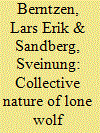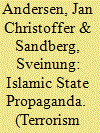| Srl | Item |
| 1 |
ID:
134985


|
|
|
|
|
| Summary/Abstract |
Anders Behring Breivik, a lone wolf terrorist, killed 77 people in two terrorist attacks in Norway in 2011. This study uses framing theory from social movement studies to compare his Manifesto with the rhetoric of the anti-Islamic movement that inspired him. The anti-Islamic movement has a dual, and sometimes inconsistent, collective action framing. On the one hand, they portray Islam as an existential threat to the West and a warlike enemy; on the other, they promote peaceful and democratic opposition. The potential for radicalization is thus immanent. This case study reveals the importance of seeing lone wolf terrorists as acting from rhetoric embedded in larger social movements. It further demonstrates, in detail, the subtle and complex ways in which political narratives rejecting terrorism and political violence still end up inspiring such acts.
|
|
|
|
|
|
|
|
|
|
|
|
|
|
|
|
| 2 |
ID:
175735


|
|
|
|
|
| Summary/Abstract |
The Islamic State (IS) has become notorious for violent, brutal actions and the presentation of these actions in social and mainstream media. Excessive violence creates a spectacle for the news media. However, IS propaganda also emphasizes its role in state building and its engagement in social and welfare work. This twofold propaganda enables the mobilization of different audiences, but it also sends conflicting messages about the organization. In this article, we study the e-magazine Dabiq, emphasizing its methods of gaining support and attempting to recruit Western participants to violent jihadism. We use theories of social movement and subculture to reveal some of the underlying tensions in IS’s communicative strategies. The analysis first identifies how IS frames its propaganda, attempting to mobilize widespread support. Then, it highlights another dimension of IS’s rhetoric: provocations, the creation of sensationalist spectacles of violence and links to excitement seeking, stardom, and popular culture. We conclude that combining general anti-Western rhetoric and religious imagery with extraordinary depictions of violence has been both a strength and flaw in the organization’s propaganda.
|
|
|
|
|
|
|
|
|
|
|
|
|
|
|
|